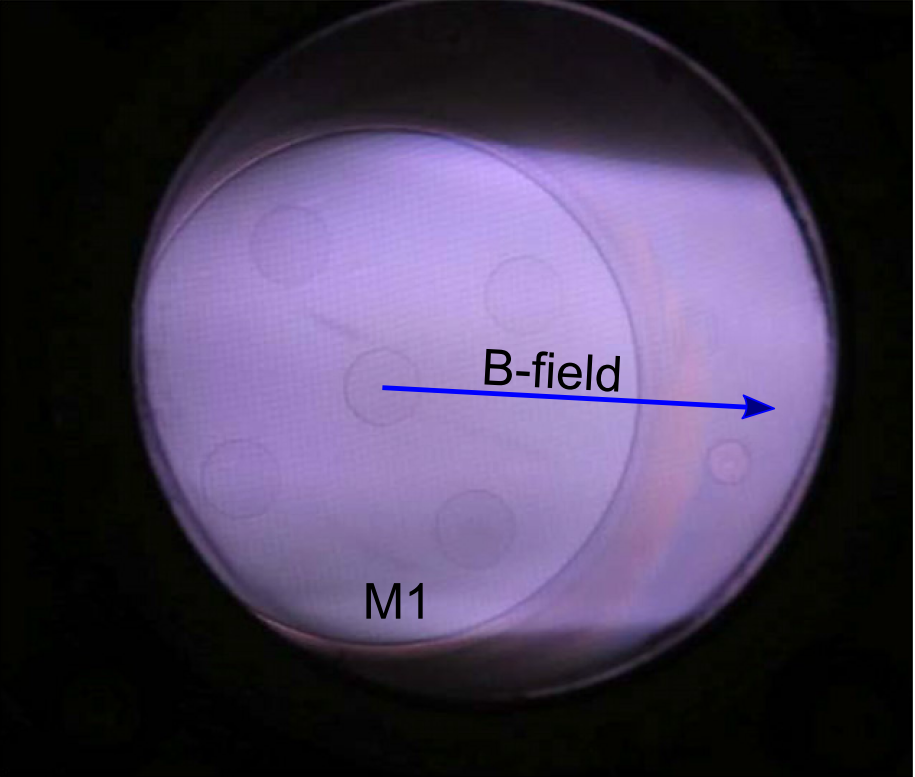Metallic first mirrors (FMs) make up important components in many of the optical diagnostic systems in the fusion reactor ITER. They are responsible for directing the light from the fusion plasma towards the diagnostic sensors through an optical labyrinth to prevent neutron leakage. However, being the initial elements in the optical path, the FMs are subject to constant erosion from charge exchange neutrals as well as deposition of the first wall materials: beryllium (Be), tungsten (W) and their oxides, which would significantly degrade their optical properties. The FMs would hence require regular cleaning to restore their optical properties which, among other techniques, is foreseen to be achieved by in situ capacitively coupled radio-frequency (CCRF) plasma cleaning technique. In ITER, most of the mirror cleaning operations are expected to be executed in the presence of the toroidal magnetic fields in the range of 3 to 3.8 T at the locations of the FMs. The presence of fields of this magnitude would significantly influence the cold plasma properties, particularly the bias voltage on the mirror, ion directionality and flux spatial distribution, all of which can significantly affect the mirror cleaning rate and uniformity. Hence, it is crucial to investigate plasma cleaning of FMs in presence of strong magnetic fields. In this study, we experimentally investigated the influence of a 3T magnetic field on the RF discharges, wall sputtering and deposition on FMs in an ITER sized mock-up of a first mirror unit (FMU) with Cu walls. The FMU consisted of two electrodes M1 and M2 serving as the first and second mirrors, wherein M1 was powered and M2 grounded.
Initially, an experimental discharge was conducted without magnetic field to serve as a reference. The discharge was generated with an RF power of 55 W and allowed to run for 8.5 h. The plasma potential Vp as measured by a Langmuir probe (HIDEN’s ESPionTM) was roughly 60 V at these parameters, corresponding to ion energy of ∼60 eV on M1, M2 as well as on the walls. In the absence of a magnetic field, the plasma expands throughout the FMU, maximizing the area of the walls sputtered, which was deposited on M1 and M2.
In presence of magnetic field, the plasma discharge was confined in a beam extending in the direction of the magnetic field as can be observed in figure 1, consequently wetting a limited portion of the FMU walls. In the DC-decoupled scheme (without λ/4 filter), this considerably influenced the self-bias voltage VDC that develops on M1. Changing the angle α between M1 normal and magnetic field, modified the plasma wetted wall area Ag as can be observed in figure 2 and the resulting VDC varied by over two orders of magnitude. The self-bias voltage also increases with RF power due to an increase in the ionization potential. However, for any given parameter the self-bias voltage is maximum in the absence of a magnetic field since the discharge wets the entire FMU compared to a limited portion in the presence of a magnetic field. Plasma exposure experiments were also done in the DC-coupled scheme (with λ/4 filter), wherein the angle and wetted surface determined the area of wall sputtered. Increasing α led to an increase in the sputtered wall area Ag, and consequently the wall deposition on grounded M2. However, in all the cases M1 was entirely clean except for edge deposits in some. In contrast, both M1 and M2 are coated with wall deposits in the absence of a magnetic field and a similar plasma exposure.
The results show that plasma cleaning with λ/4 filter in a 3 T magnetic field at ITER could potentially prevent the parasitic wall deposition on FMs. The results also highlight the importance of FM orientation in the magnetic field and the wetted area in the plasma cleaning in both the DC-coupled and decoupled schemes within the ITER diagnostic systems.

Figure 1: Image of the confined plasma column extending from M1 in the direction of magnetic field

Figure 2: Illustration of the plasma column in magnetic field and the corresponding wetted ground area Ag in the FMU, with varying angle α.
 Project summary by: Kunal Soni, Department of Physics, University of Basel, Klingelbergstrasse 82, CH-4056, Basel, Switzerland
Project summary by: Kunal Soni, Department of Physics, University of Basel, Klingelbergstrasse 82, CH-4056, Basel, Switzerland
Paper Reference: “Effect of 3 T magnetic field on RF plasma sputtering in an ITER-relevant first mirror unit”, Nuclear Fusion (2022) 62, 126009 DOI 10.1088/1741-4326/ac8b20
Hiden Product: ESPion
Download PDF: AP-ESPion-202130
To find out more about these products visit the ESPion product page or if you would like to contact us directly please Send us a Message.

